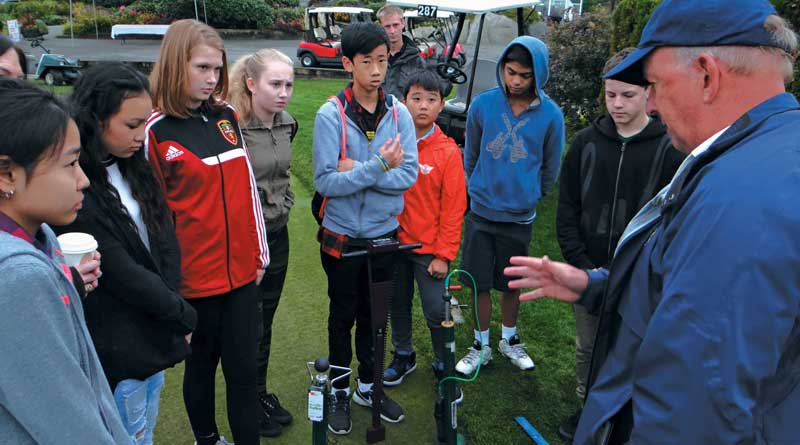The Life of a USGA Agronomist


Outside of longtime touring professionals, Larry Gilhuly ranks among golf’s all-time peripatetic people, although you might not have foreseen that back in the late-1960s.
Beginning in 1968-72, when he was hired on as a summer maintenance worker at Longview (Wash.) Country Club, the always-engaging Gilhuly became a summer turfgrass intern at Seattle’s Broadmoor Golf Club in 1973-74 and then assistant superintendent at Seattle Golf Club from 1975-83.
Gilhuly, now 64, then made a momentous career move that he maintains today, joining the USGA’s Green Section as an agronomist for the Northwest and, now, West region. That was 33 years ago. As part of his Course Consulting Service visits, the proud Washington State University grad (BS degree in Agronomy and Turf Science) and former Evans Caddie Scholar averages nearly 125-course visits annually, with a high of 205 in 1986.
“If my WSU math is correct,” quips Gilhuly, “that would be 4,125 total visits, but not 4,125 different golf courses. Probably around 1,000 to 1,100 different courses.”
When asked about the total mileage he’s ventured in his job, Gilhuly can only guesstimate. “Wild guess would be nearly 2 million miles when driving and flying are added together. Visits over the years have included California, Arizona, Utah, Nevada, Wyoming, North Dakota, South Dakota, Montana, Idaho, Washington, Oregon, Colorado, Alaska, and Hawaii. Also, British Columbia, Alberta, Saskatchewan, Manitoba, Mexico, Japan, South Korea, Guam, Mainland China, Scotland, Ireland, and England.”
“The USGA Green Section, headed by Managing Director Kimberly Erusha, is currently comprised of four regions – Northeast, Southeast, Central and West – after a reshuffling of areas a few years ago. Erusha oversees six people at USGA headquarters in Far Hills, N.J., while each Green Section Region has a director…
Collectively, since 1953 USGA Green Section agronomists have made more than 75,000 visits to golf courses; driven more than 16 million miles; spent more than 64,000 nights (the equivalent of 175 years!) on the road; and spent more than 450,000 hours driving, equal to about 19,000 days or 50 years.
The USGA Green Section, headed by Managing Director Kimberly Erusha, is currently comprised of four regions – Northeast, Southeast, Central, and West – after a reshuffling of areas a few years ago. Erusha oversees six people at USGA headquarters in Far Hills, N.J., while each Green Section Region has a director and 11 agronomists, such as Gilhuly, nationwide.
In addition to its Course Consulting Service, the USGA Green Section evaluates and funds research projects; since 1920 it has provided more than $40 million for work conducted at universities around the country. Sustainability and environmental protection at golf courses are two key elements of these projects.
The group also serves a major role in on-course preparations at all USGA championship venues. Staff agronomists work with maintenance staff before, during, and after each tournament to optimize playing conditions for competitions while using best management practices to preserve turfgrass health. As an example, Gilhuly spent months in advance of the 2010 U.S. Amateur and 2015 U.S. Open at Chambers Bay in University Place, Wash., just across Puget Sound from his home in Gig Harbor.
The Green Section’s largest geographic region, by far, is the West, which takes up nearly half of the U.S. It encompasses 15 far-flung states: Alaska, Hawaii, Washington, Oregon, California, Idaho, Nevada, Utah, Arizona, Montana, Wyoming, Colorado, New Mexico, and North and South Dakota.
Gilhuly’s primary focus is in Hawaii, Oregon, Montana, Idaho, Wyoming, Alaska, and Washington. But his territory also includes 364,764-square-mile British Columbia along with the equally vast Canadian provinces of Alberta, Saskatchewan, and Manitoba.
As for his chief mission on the site visits (which cost a golf facility $2,100 for a half-day and $3,200 for a full day), Gilhuly speaks for his cohorts when he says: “Our visits provide an outside and unbiased view of the golf course to enhance both agronomic and playing conditions for those maintaining and playing the facility. We bring a large amount of up-to-date information on virtually every topic pertaining to the maintenance of the golf course.
“If one of us does not have the answer, we can find it instantly from one of our other 15 agronomists in the Green Section.”
Following a visit accompanied by the superintendent and maintenance staff – as well as Green Committee and club members – USGA agronomists write up a detailed report, with recommendations for improvements. “Our follow-up reports are timely, always keep the golf course budget in mind and offer a written history of the maintenance program or changes that have occurred. Our philosophy is to help outline the best turf-growing conditions possible to provide the best playing conditions, based on the golf course budget.”
Among the biggest contemporary concerns are the intrusion of trees, the development of forwarding tees, and water conservation. “Perhaps one of the biggest topics is trees,” Gilhuly notes. “The constant battle for sunlight, water, and fertilizer will always be in favor of the larger cousin of grass. Good turf growth is compromised when these three factors are removed, resulting in thin/weak turf, more disease, and reduced playing conditions.
“When trees are scientifically removed, with (assistance from) simple (computer) apps that are now available, turf growth and playing conditions are improved.”
No. 2 on the list is the addition of forwarding tees to improve the “fun factor” and address a changing demographic. “With age comes less length for both genders, thus many courses have opted to include well-built and adequately-sized forward tees,” Gilhuly comments. “Also, the simple removal of the red (tee) color has had a very positive impact at many courses. When players move forward, the pace of play is also enhanced.”
Gilhuly reveals that the USGA is in the process of a new initiative that may be implemented in 2017. “We are working hard at coming up with new ways to address this (water) issue with a new one (called the ‘USGA Resource Management Tool’). Essentially, this allows USGA agronomists to work with golf course superintendents on pinpointing where golfers are using the golf course and where changes to maintenance patterns can occur.”
Of his important job, Gilhuly echoes the tenets of fellow Green Section staff members. “We hope to significantly reduce overall maintained acreage to reduce water use, fertilizers, pesticides, gas, equipment wear and labor at any golf course.”
Jeff Shelley has written and published nine books as well as numerous articles for print and online media over his lengthy career. Among his titles are three editions of the book, “Golf Courses of the Pacific Northwest.” The Seattle resident was the editorial director of Cybergolf.com from 2000-15. For seven years he served as the board president of First Green, an educational outreach program that is now part of the Golf Course Superintendents of America and Environmental Institute for Golf.
Recent Posts
The Rare Condor: What It Means for Golf and the Course Maintenance Behind It
Imagine this: you're on a par-5, having just hit your second shot toward the green.…
DENIOS Under Bench Cabinet Provides Safe Storage of Lithium-Ion Batteries
DENIOS introduces asecos under bench cabinets for the safe storage of undamaged lithium-ion batteries. They…
True Blue Golf Club, One of America’s Top 100 Resort Courses, Acquires Steve Dresser Golf Academy
True Blue Golf Club has acquired the Steve Dresser Golf Academy, a renowned instructional facility…
Memphis Country Club: A Golfer’s Study in Precision and Tradition
If you have ever teed it up at Memphis Country Club, you know this isn’t…
Superintendents Online Turf Directory – EVERYTHING TURF
Our online directory, directory.GolfCourseTrades.com is the go-to resource for the busy superintendent. It is your opportunity…
Foley Company attains GCSAA Silver Partner Status
Foley Company, a leader in turf equipment innovation and technology, affirms its support of the…


